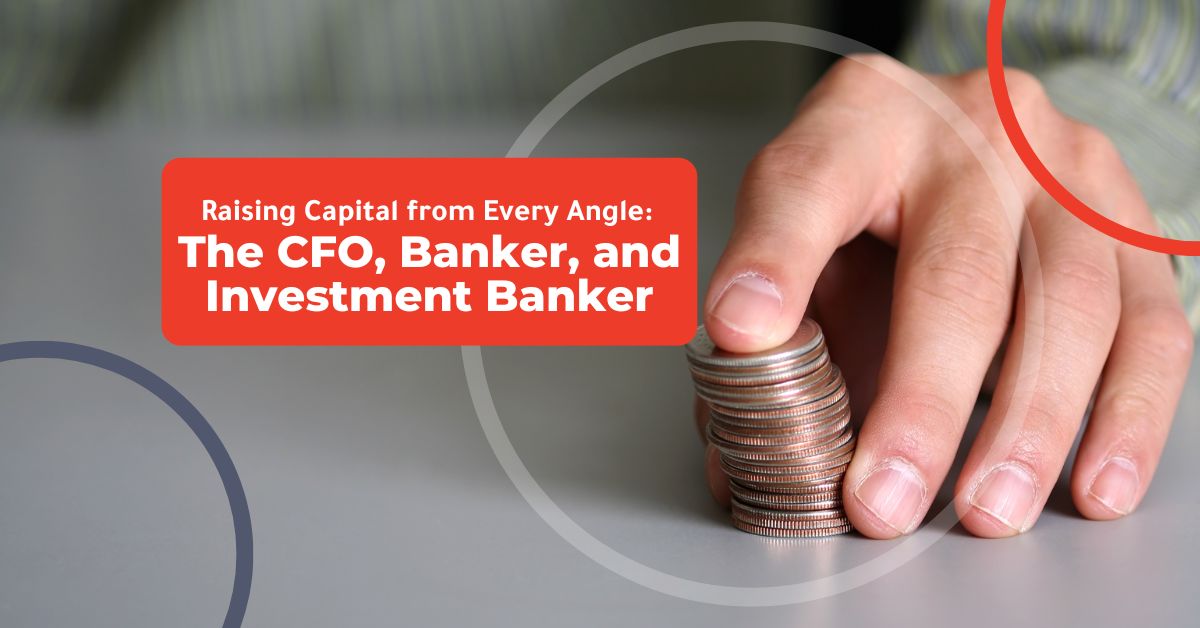Raising Capital from Every Angle: Insights from a CFO, Banker, and Investment Banker
Sep 3, 2025
Raising capital is a leadership decision. It shapes your company’s financial structure, long-term strategy, and path to growth. Whether you’re considering a line of credit, pursuing private equity, or preparing for a major transaction, how you show up to capital conversations communicates a lot about your business even before you make the ask.
Inexperienced founders often assume capital is awarded to great ideas. Seasoned operators understand capital flows to businesses that demonstrate readiness, transparency, and trust. If you can anticipate what lenders and investors prioritize, and prepare accordingly, you’ll be in a much stronger position.
Understand Who You’re Talking To
Not all capital is the same, and not all providers think alike. Before preparing your pitch deck or financials, get clear on the perspective of the person across the table.
1. Banks Want Safety
Banks aren’t investors. They don’t want a share of your success; they want their money back with interest. They’re looking for low risk, which means:
- Demonstrating cash flow to cover debt service
- Providing strong collateral
- Showing stable operating history and clean financials
2. Investment Firms Want Return
Private equity, venture capital, and institutional investors focus on valuation and upside. They evaluate your growth potential, leadership team, exit options, and operational leverage. A compelling story gains traction when it is supported by a well-defined strategy, credible data, and a specific use of funds.
3. Lenders and Investors Avoid Surprises
Across the board, surprises can destroy deals. “All cards face up, all the time,” says ProCFO Joe Briner. Whether it’s historical challenges, legal issues, or market setbacks, disclose early. Markets tend to accept disclosed challenges when they are presented early and clearly. Hidden issues, when discovered late in the process, will create friction or derail trust.
Prepare Before You Pitch
Preparation requires having your house in order. Before worrying about your pitch deck, make sure your team, your numbers, your story, and your structure are aligned.
1. Clean Up Your Financials
This sounds obvious, but too many companies walk into capital conversations with outdated reporting, missing documentation, or confusing metrics. You should be able to:
- Explain variances in your P&L
- Provide up-to-date forecasts and working capital needs
- Support all assumptions with credible rationale
If you’re not already reviewing financial performance monthly, your business isn’t ready to raise capital.
2. Build a Cohesive Narrative
A strong story connects your financials to your mission, opportunity, and market position. Avoid disconnected storytelling. Instead:
- Frame your ask around a specific milestone (e.g., expansion, acquisition, R&D)
- Align growth assumptions with industry trends or comparables
- Articulate why this is the right time for funding
3. Stress-Test Your Assumptions
Have a third party challenge your numbers and underlying logic. You want to find the cracks before a lender or investor does. If your pitch only works in a best-case scenario, it needs more work.
4. Be Specific About Capital Strategy
Instead of simply stating, “We’re raising $5 million,” be ready to explain:
- How much will come from debt, equity, or a hybrid structure
- What the funds will be used for, in practical terms
- What return or structure you’re offering
- How you determined your terms and why they are reasonable
A vague raise structure, even with a strong business, can derail a conversation.
What to Avoid: Common Capital Missteps
Confusing Optimism With Planning
Belief in your business matters, but capital providers are evaluating risk. You need to show you’ve planned for challenges and taken steps to mitigate them.
Underestimating the Process
Raising capital takes time. Even straightforward deals can involve months of diligence, documentation, and negotiation. If you start too late, you lose leverage.
Approaching the Wrong Capital Source
Not every capital source is a fit. Venture capital probably isn’t right for steady-growth businesses. Banks aren’t usually a great fit for high-burn startups. Match the source to the strategy.
The Role of the CFO in Raising Capital
Capital strategy is a leadership function that sits squarely on the shoulders of the CFO. And too often, companies underestimate what that role involves.
A CFO who focuses only on compliance and reporting will miss key signals in the market. And one who overstates the business without operational structure can undermine credibility. The right CFO does much more than present the numbers. They interpret risk, align financial reality with strategic vision, and speak fluently to lenders, investors, and internal stakeholders.
Here’s what you should expect from your CFO during the capital raise process:
- Scenario Modeling: They should build and vet multiple funding paths, including worst-case and breakeven scenarios, not just the ideal case.
- Stakeholder Framing: Your CFO should adjust the story for different audiences. What a private equity firm needs to hear differs from what a commercial bank requires.
- Due Diligence Readiness: A good CFO prepares documentation before it’s requested. They anticipate questions and surface answers before issues arise.
- Use-of-Funds Planning: Capital doesn’t just need to be raised. It needs to be allocated with precision. Your CFO should connect every dollar to a business case and expected return.
- Risk Communication: Investors want confidence, not perfection. A strong CFO identifies the risks, explains the mitigations, and shows the strategy for handling downside events.
If your company doesn’t currently have a CFO in place, that absence may already be affecting how your business is viewed by capital providers. Yes, it’s important to have someone who can speak to numbers, but more essential is someone who can lead the financial strategy and represent the business in the language capital understands.
A fractional CFO can provide this leadership with flexibility. Whether you need ongoing support or project-based capital planning, working with the right fractional CFO gives you access to executive-level insight without the full-time overhead. For many companies, this structure allows them to level up their financial strategy exactly when it’s needed most; during growth, change, or transition.
If you’re preparing to raise capital, your CFO shouldn’t be brought in at the end just to review the numbers or presentation. They should be architecting the process from the start.
Bonus Considerations
Keep Reporting Current
Even if you’re not actively raising, act as though you might be. Discipline in reporting builds flexibility, readiness, and confidence with potential capital partners.
Build Relationships Before You Need Them
Don’t wait until you’re short on cash to meet lenders or investors. Early conversations give you insight into what they’re looking for. That gives you time to prepare.
Tailor Every Pitch
Generic pitches tend to fall flat. Bankers focus on repayment, while investors are more interested in your long-term growth story. Tailor your message to match their priorities.
Capital Depends on Focus and Fit
Strong businesses with good ideas still miss out on capital when they fail to prepare, plan, or present well. Lenders need to see risk minimized. Investors need to see return maximized. Both need to trust the leadership across the table.
When you present a well-prepared company with clean financials, a clear strategy, and a compelling ask, you increase your odds dramatically. If you lead the conversation with transparency, readiness, and respect for the capital partner’s perspective, you turn fundraising into a strategic advantage rather than a financial scramble.
Approach capital decisions as long-term commitments that shape your company’s direction. This mindset helps attract stronger partners and leads to more sustainable outcomes.


